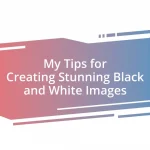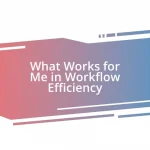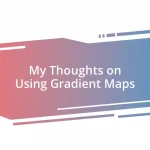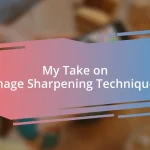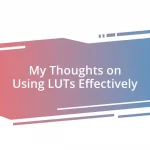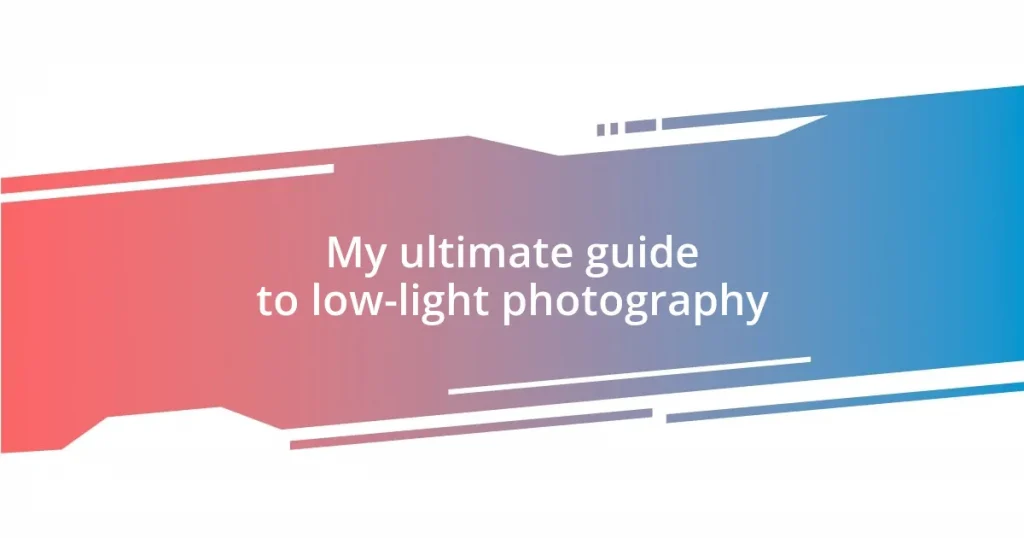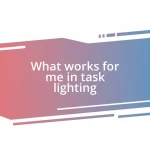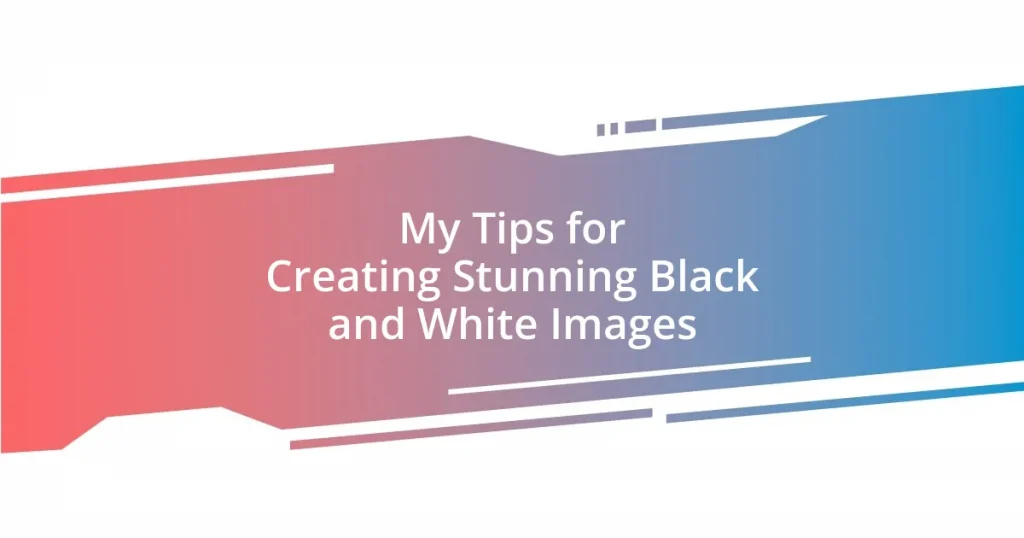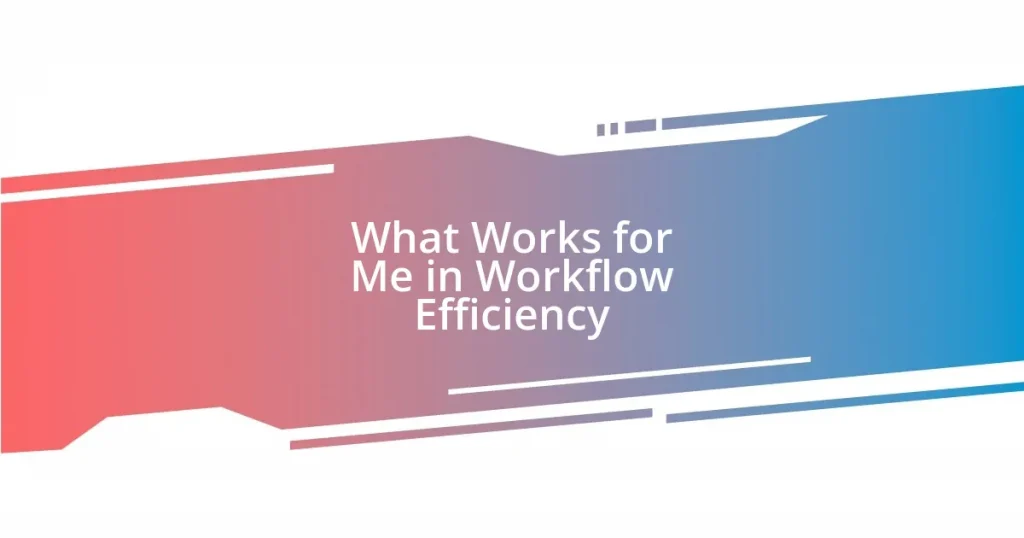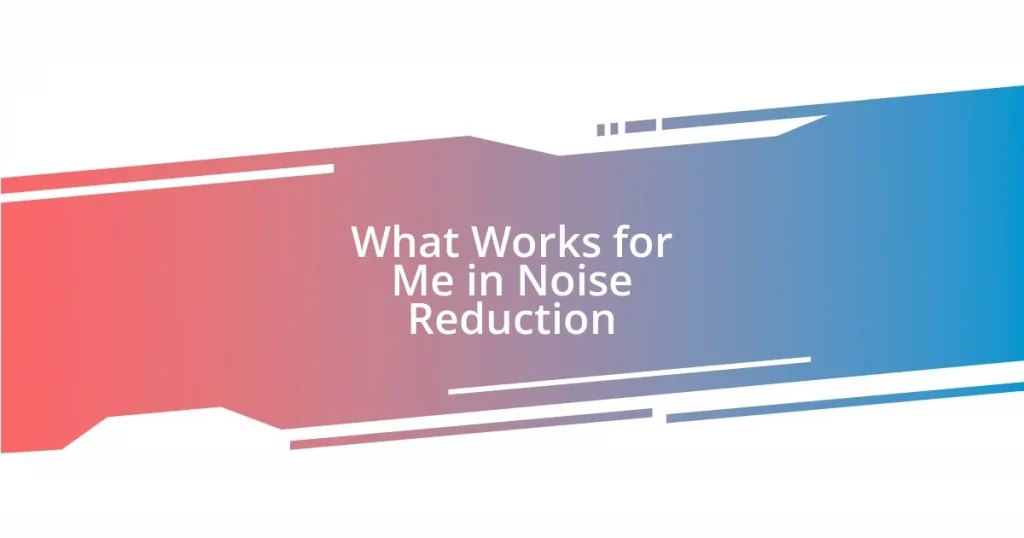Key takeaways:
- Low-light photography is about embracing challenges and using techniques like adjusting ISO, shutter speed, and aperture to capture emotional scenes.
- Proper equipment, including wide aperture lenses, tripods, and cameras with high ISO performance, is essential for successful low-light photography.
- Editing techniques such as exposure adjustment, noise reduction, and enhancing shadows and highlights can significantly improve low-light images.
- Avoid common mistakes like improper aperture settings, neglecting white balance adjustments, and incorrect focusing to achieve better results in low-light conditions.
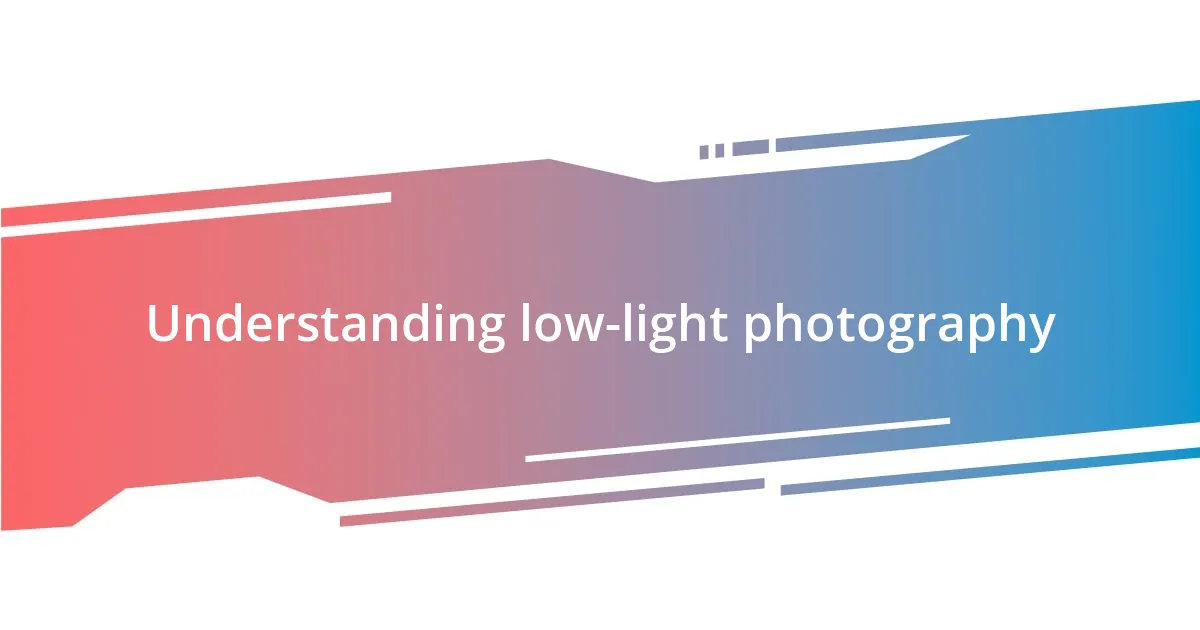
Understanding low-light photography
Low-light photography can feel like a dance between shadows and light, and I often find myself captivated by how some images come to life in these conditions. Have you ever noticed a moment that seemed too dim for a traditional camera to capture? It’s about embracing the challenge and finding beauty where others might overlook it.
I remember standing in a dimly lit café, the warm glow of fairy lights creating a cozy atmosphere. When I fiddled with my camera settings, I was amazed at how a simple snapshot transformed into a dreamy portrayal of that moment, rich in texture and mood. This experience taught me that low-light photography isn’t just about lower visibility—it’s about unlocking the emotional potential of the scene.
The key lies in understanding how to manipulate exposure settings: increasing ISO to enhance sensitivity, slowing down your shutter speed to let in more light, or widening your aperture to create that beautiful bokeh effect. Each of these techniques gives you a unique way to interpret the quieter, often overlooked whispers of light in a scene, making low-light photography a truly expressive medium.
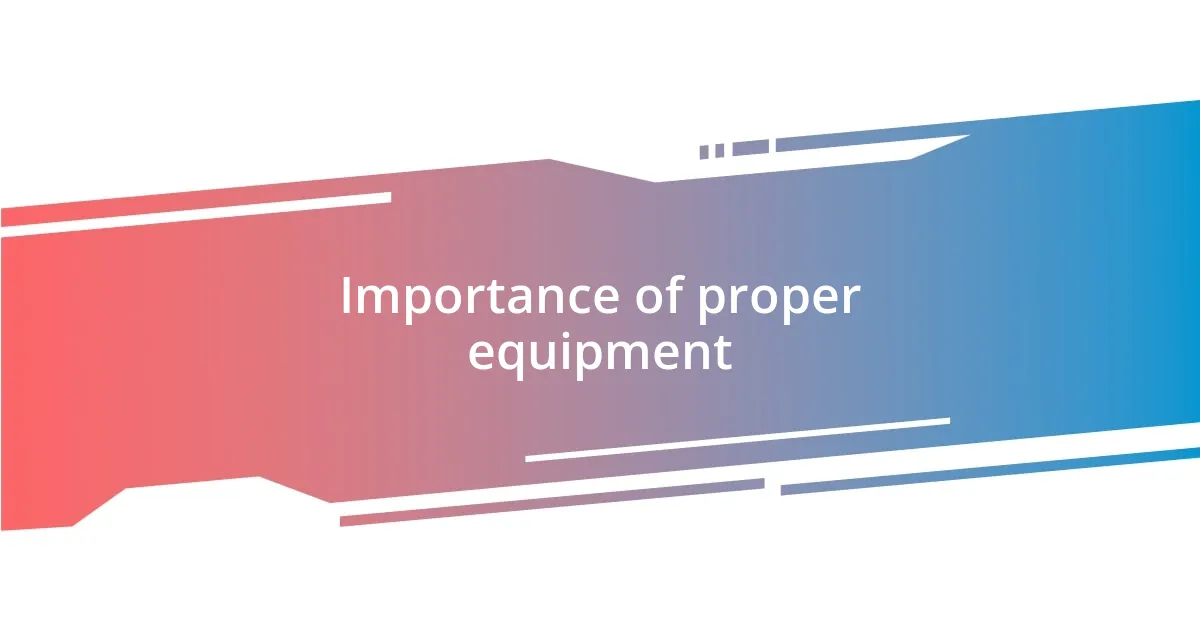
Importance of proper equipment
When it comes to low-light photography, having the right equipment can make a significant difference. I remember my first attempts with a basic camera, and I struggled to get clear images in dim environments. It wasn’t until I invested in a faster lens with a wide aperture that I truly began to appreciate the transformative power of my gear.
Choosing the right equipment includes:
- Wide Aperture Lenses: These allow more light to enter, increasing the chances of capturing a balanced exposure.
- Tripods: Stability is crucial; even the smallest shake can ruin a long exposure shot.
- Camera with High ISO Performance: A camera that handles high ISO well reduces noise, enabling you to capture clearer images even in darkness.
- External Flash: In moments where ambient light isn’t enough, a versatile external flash can bring scenes to life without compromising the mood.
Each of these tools has proven invaluable in my own low-light adventures, transforming challenging situations into opportunities for stunning photography.
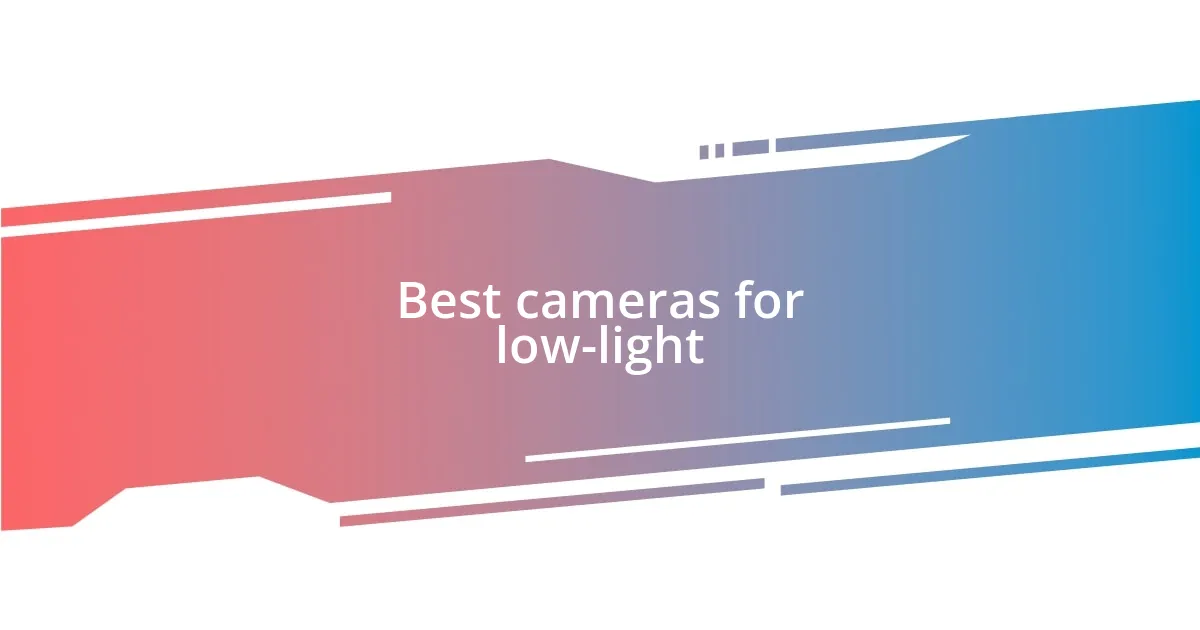
Best cameras for low-light
Choosing the right camera is pivotal for successful low-light photography. From my experience, cameras with larger sensors tend to perform significantly better in dark settings because they capture more light. I remember using a full-frame camera during a night event; the results were astonishing. Bright, vibrant images with minimal noise felt like magic as I reviewed them, even in the most dimly lit corners of the venue.
While it’s easy to get overwhelmed by the array of options out there, I’ve found that several models consistently stand out for low-light performance. Take mirrorless cameras, for instance. They’ve really shined in my low-light sessions, thanks to their compact build and impressive autofocus capabilities. On one occasion, I shot a concert with a mirrorless model, and I couldn’t believe how well it focused and captured the performers against the backdrop of stage lights.
When selecting a camera, you also want to think about features like image stabilization, which is crucial when you’re shooting without a tripod. Having a camera that minimizes shake allows for sharper images, even in challenging conditions. Personally, investing in a camera with great stabilization made a world of difference on my last trip to the city at night. The streets came alive as I snapped shots effortlessly, even while walking.
| Camera Model | Sensor Type |
|---|---|
| Canon EOS R6 | Full-Frame |
| Nikon Z6 II | Full-Frame |
| Sony A7 III | Full-Frame |
| Fujifilm X-T4 | Cropped Sensor |
| Panasonic Lumix GH5 | Cropped Sensor |
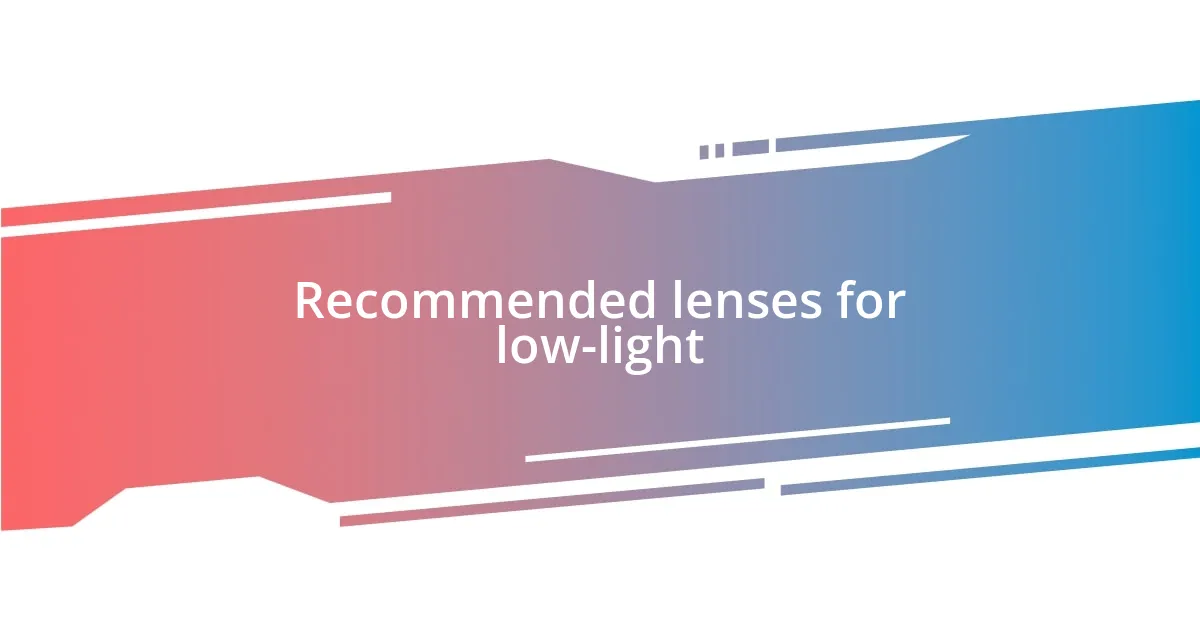
Recommended lenses for low-light
When I dive into low-light photography, my go-to lenses are always those with a wide aperture. A lens like the 50mm f/1.8 is not just affordable but also allows an impressive amount of light to hit the sensor. I remember capturing portraits under fairy lights at a friend’s wedding; the bokeh effect around the subjects was simply enchanting, creating a dreamy atmosphere that would have been impossible with a narrower aperture.
For situations where I need a bit more versatility, I often reach for a 24-70mm f/2.8 lens. This lens has been my trusty companion during night market explorations. I recall a vibrant evening where I effortlessly switched from wide shots of bustling stalls to intimate close-ups of street food. The lens performed beautifully, maintaining sharpness without losing the magic of the dim lighting around me. It’s moments like these that remind me how crucial the right lens can be in enhancing the stories I want to tell through my photos.
However, it’s not just about aperture. I’ve found that a lens with image stabilization can make a huge difference in low-light settings. Take my experience at an outdoor concert; the stage lights flickered beautifully, but so did my hands! Fortunately, I used a lens with stabilization, which helped me capture the artists performing without the shake ruining the shot. Have you ever faced that frustrating moment when your photo is just a blur? Trust me, investing in the right lens can save you from that disappointment.
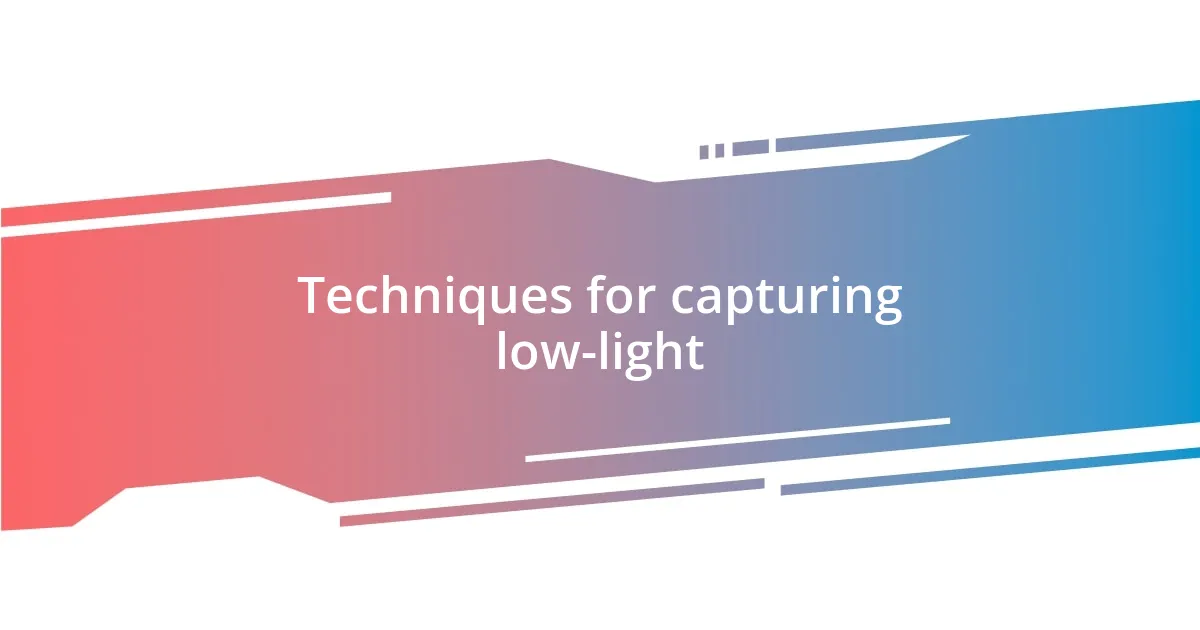
Techniques for capturing low-light
One of my favorite techniques for low-light photography is adjusting the ISO sensitivity. By increasing the ISO, you amplify the sensor’s sensitivity to light, allowing you to capture brighter images in dark environments. I once ventured into an old cathedral at dusk, cranking up the ISO to 3200. The resulting photos had this incredible depth, revealing intricate details in the stained glass that were nearly invisible to the naked eye.
Another essential technique I’ve embraced is using longer exposure times. By keeping the shutter open longer, I can capture more light, which is particularly beneficial for night landscapes or star trails. Just last summer, I set my camera on a tripod at a remote beach and left the shutter open for 30 seconds. The ethereal glow of the stars above was absolutely mesmerizing, and I felt a sense of tranquility wash over me as the scene unfolded.
Lastly, employing a steady hand or using a tripod cannot be overstated. Whenever I try to capture cityscapes at night, I always bring along a sturdy tripod. I recall a bustling street lined with neon signs; without my tripod, those bright bursts of color would have turned into a blurry mess. Isn’t it fascinating how the right support can turn a simple shot into a work of art? Remember, the clearer your base, the clearer your photo!
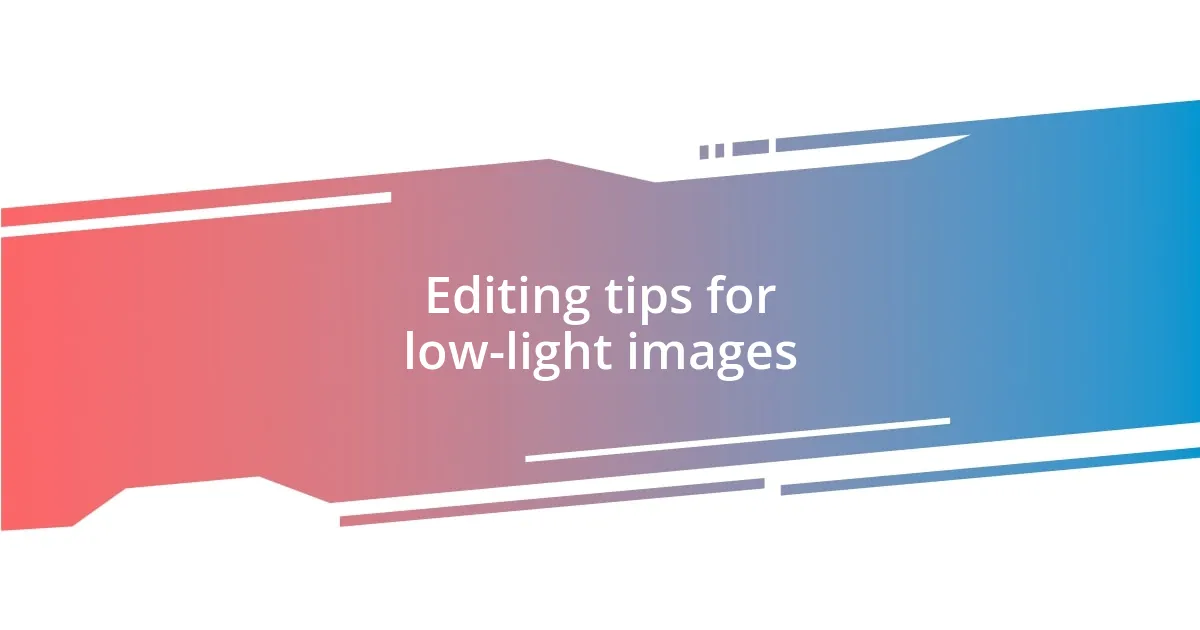
Editing tips for low-light images
One of the most transformative steps I’ve taken when editing low-light images is adjusting the exposure levels. I recall adjusting the brightness of a photo I took during a dimly lit concert. With just a small bump in exposure, the atmosphere shifted—those vibrant colors sprang to life without losing the organic feel of the surroundings. Have you ever seen a dull photo burst into brilliance with minimal adjustments? It can be quite surprising to see how a bit of fine-tuning can enhance the image’s emotional impact.
Noise reduction is another key aspect that I swear by in post-processing. Low-light environments often introduce a grainy texture to your images, which can be distracting. I once edited a night shot of a city skyline that initially felt rough and unpolished. After applying a noise reduction tool, the scene transformed, bringing forth those delicate twinkling lights in a much smoother way. It’s a perfect reminder that sometimes less is more—removing distractions allows the beauty of the moment to shine through more clearly.
Lastly, I find that enhancing shadows and highlights breathes life into my low-light shots. When I edited a moody image of lanterns glowing softly on a winter’s night, adjusting the highlights added that magical glimmer, while lifting the shadows helped preserve the surrounding darkness. Don’t you just love when the right edits evoke the feeling you aimed to capture? The right balance can tell a more profound story and make a low-light moment truly unforgettable.
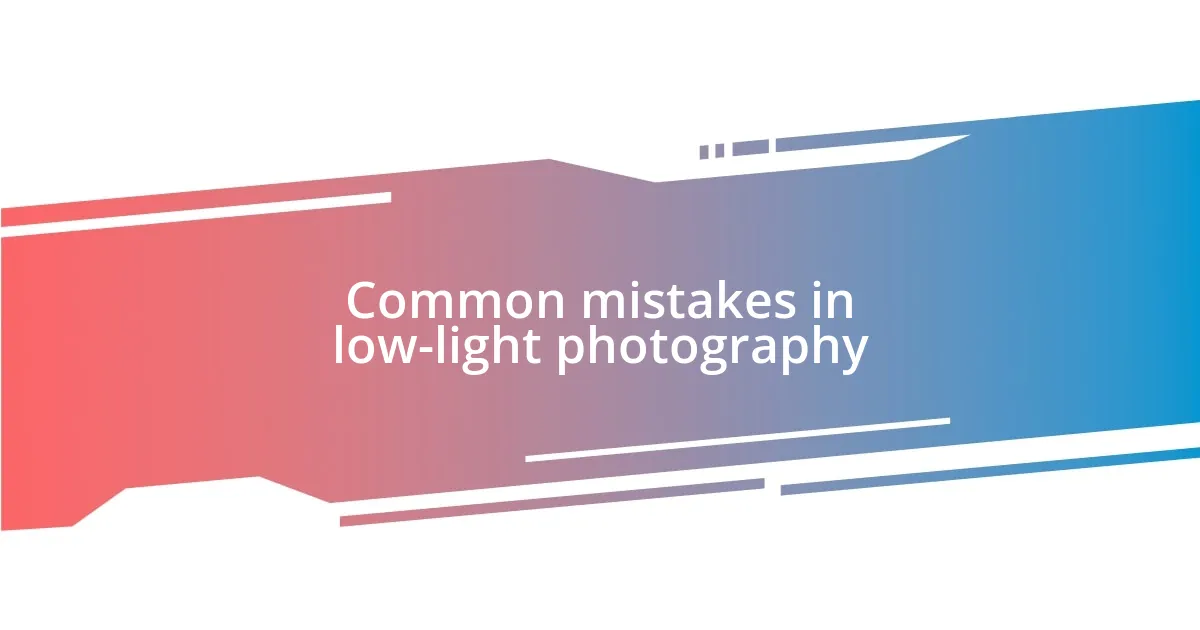
Common mistakes in low-light photography
One common mistake I see in low-light photography is the tendency to shoot without considering the aperture settings. I remember a late-night street photography session where I shot at a tight aperture, thinking it would give me more depth of field. Instead, the images were darker and lacked that dreamy glow I wanted. Have you ever made a similar choice and regretted it? Sometimes, opening up the aperture can let in more light and create a soft background, transforming an ordinary shot into something magical.
Another frequent error is neglecting white balance adjustments. In a dimly lit café, I snapped a few quick shots, forgetting to change my white balance from daylight to incandescent. The resulting photos had an unflattering yellow hue that completely obscured the cozy vibe of the space. It’s those little details that make a significant difference, don’t you think? Taking the extra moment to adjust your camera settings can mean the difference between a lifeless photo and a vibrant one that truly captures the atmosphere.
Lastly, I often see photographers overlooking the importance of focusing correctly in low light. During one twilight hike, I misjudged the focus while trying to capture some glowing fireflies. My excitement led to some heartbreaking out-of-focus images. It’s a reminder that even in the thrill of the moment, taking a bit of time to lock in focus can save you from that regret later. Have you faced similar disappointments? Trust me; a little patience can ensure you capture those fleeting moments sharp and clear.
